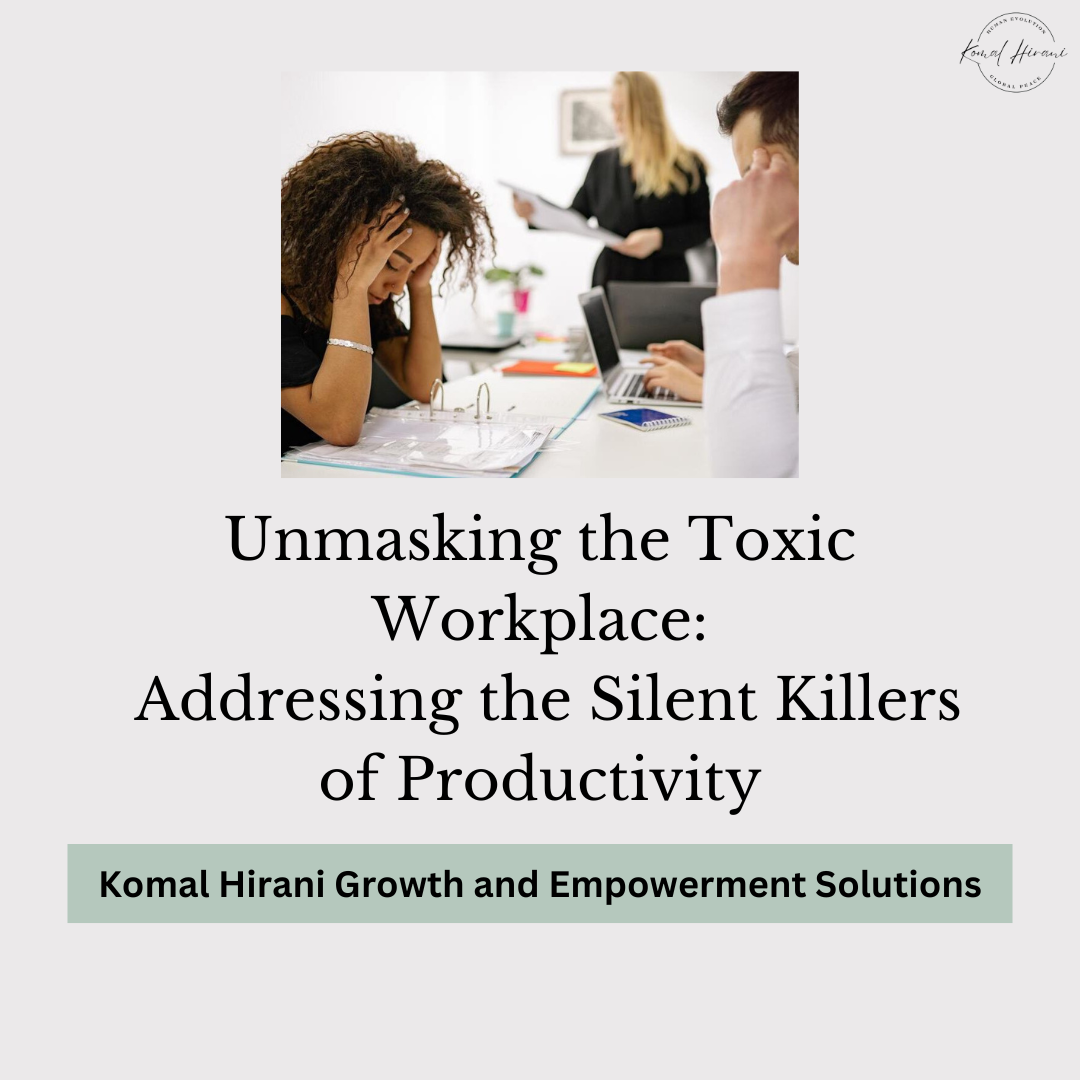Picture this scene: you walk into your office with anticipation for the day ahead. The air is filled with the buzz of productivity as colleagues exchange genuine smiles and meaningful dialogue. You feel motivated, supported, and respected. How do you feel? Does it motivate you enough to begin the day on a good note? Has it inspired you enough to give your best at the workplace already?
I hope the answer is yes for most of you, great!
But unfortunately, this is not the case for everyone. A Toxic Workplace can cast a dark cloud over the work environment, hindering productivity, eroding morale, and negatively impacting mental health. In this article, we will explore the concept of toxicity at work, understand why the toxic work culture prevails and its psychological basis, draw comparisons to healthier alternatives and explore practical strategies for fostering a positive work culture.
Toxicity at the workplace takes various forms, such as bullying, harassment, lack of trust, no room for mistakes, micromanagement, role confusion, office gossip, excessive stress and a general lack of respect or empathy among colleagues. These behaviours breed negativity and feelings of powerlessness. Toxic environments drain employees of their passion and creativity, increasing unproductivity and absenteeism.
Reasons and Tentative Solutions for a Toxic Workplace
In recent years, there has been a growing concern about toxic work cultures and their prevalence in various organizations. Several factors contribute to the emergence and persistence of destructive work cultures in today’s professional landscape. Let us understand a few reasons behind it and the tentative solutions for each as well:
- High Workload and Stress:
In today’s ever-evolving world, it feels like we’re always racing against the clock. Long hours, tight deadlines, and overwhelming workloads have become the norm. This constant pressure takes a toll on our mental and emotional well-being. We find ourselves exhausted, on the edge of burnout, and struggling to cope.
In such moments, our patience wears thin, and toxic behaviour can permeate our interactions with others. When we are overwhelmed and overworked, it becomes easier to snap, criticize, or engage in toxic exchanges that we later regret.
How can we fix it? – It is crucial to prioritize self-care and establish healthy boundaries when dealing with high workloads and stress. This could involve setting realistic goals, delegating tasks, and practising effective time management. Colleagues or supervisors can assist with redistributing workloads and reducing stress.
One should not hesitate to ask for help from higher authorities. Implementing stress management techniques such as mindfulness, exercise, and regular breaks can provide much-needed relief and contribute to a more positive work environment.
- Lack of Leadership Accountability:
We look up to our leaders to set the tone and guide us. However, it’s disheartening when we witness poor leadership and a lack of accountability. When leaders turn a blind eye to toxic behaviour, it sends a message that such conduct is acceptable.
It creates a toxic workplace, poisoning the morale and camaraderie we desperately need to thrive. We yearn for leaders who lead by example, who address toxic behaviour head-on, and who foster a culture of respect, trust, and support.
How can we fix it? – Toxic behaviour can be addressed by leadership training that promotes effective communication, conflict resolution, and emotional intelligence. Encouraging open-door policies and establishing anonymous reporting mechanisms can also create a safe space for employees to voice their concerns. By holding leaders accountable, organizations can set the foundation for a culture of respect and integrity.
- Communication Breakdown:
We spend a significant portion of our lives at work, collaborating with colleagues and building professional relationships. However, when communication channels break down, chaos ensues. Misunderstandings, rumours, and unspoken resentments poison the air we breathe.
We long for clear and open lines of communication, where we can voice our thoughts, concerns, and ideas without fear of judgment or retaliation. Without effective communication, conflicts escalate, trust evaporates, and the toxicity that lingers corrodes our sense of belonging.
Moreover, due to working online for almost 3 years during the COVID-19 pandemic, there was a lack of face-to-face interaction and physical separation caused by remote work can impede effective communication and collaboration. The possibility of miscommunications and misunderstandings among colleagues is higher, leading to conflicts and strained relationships. The absence of non-verbal cues and informal interactions can also hinder the development of trust and rapport, further contributing to a toxic workplace.
How can we fix it? – Effective communication is vital in preventing and resolving toxic dynamics. Implementing regular team meetings, team building, feedback sessions, and training workshops on active listening and assertive communication can improve overall communication within the workplace.
Encouraging a culture of transparency, mutual respect and openness, where individuals are empowered to express themselves without fear of judgment or reprisal, can help break down communication barriers. Investing in conflict resolution training can also equip employees with the skills to navigate conflicts constructively.
- Diversity and Inclusion Challenges:
Our workplaces should be melting pots of ideas, perspectives, and backgrounds. Unfortunately, not all organizations embrace diversity and inclusion as they should. When individuals from different walks of life feel marginalized, excluded, or discriminated against, the toxicity meter starts ticking. We crave inclusive workplaces that celebrate our differences, where every voice is heard and valued. In these spaces, toxicity struggles to survive, replaced by respect, collaboration, and support that uplifts us all.
How can we address the issue? – Diversity and inclusion initiatives should be prioritized by organizations. This could involve implementing diversity training programs, creating employee resource groups, and promoting diverse hiring practices.
Encouraging open dialogue and cultural sensitivity can help address unconscious biases and promote understanding among colleagues. By celebrating differences and valuing diverse perspectives, organizations can cultivate a culture of respect, collaboration, and appreciation for everyone’s contributions.
- Inadequate Conflict Resolution:
Conflict is inevitable in any human interaction, including our work lives. However, when conflicts fester unresolved, toxic clouds loom overhead. We yearn for effective conflict resolution strategies that encourage open dialogue, understanding, and compromise.
Avoiding or suppressing conflicts only deepens the divide, nurturing a toxic atmosphere where trust erodes, and tensions simmer beneath the surface. We deserve resolution and healing, allowing us to move forward together. Resolving conflicts is crucial for minimizing toxicity in the workplace.
How to resolve it? – Organizations can establish clear conflict resolution procedures and train employees on effective conflict management. Encouraging active listening, empathy and seeking win-win solutions can promote understanding and collaboration. A mediator or facilitator can also assist parties to resolve conflict in a mutually beneficial manner.
By addressing conflicts promptly and constructively, organisations can prevent escalating toxic behaviours and promote a healthier work environment.
Understanding the Psychological Factors Contributing to a Toxic Workplace
By exploring psychological phenomena and examining real-life examples, we can gain valuable insight into this complex issue. Let’s dive in:
1)Confirmation Bias:
Our inclination towards confirmation bias plays a significant role in perpetuating toxic workplaces. For instance, imagine a scenario where a manager constantly belittles and undermines their team members. Despite clear evidence of the detrimental impact on morale and productivity, this behaviour may be rationalized or dismissed due to the manager’s perceived competence or success in achieving results. As a result, the toxic behaviour is justified or overlooked, reinforcing the toxic work culture.
Statistics from a survey conducted by the Society for Human Resource Management (SHRM) in 2020 revealed that 45% of employees felt their organizations did not effectively address toxic behaviour. This finding emphasizes the prevalence of confirmation bias, as organizations may fail to recognize the extent of toxicity and or turn a blind eye to it.
2)Bystander Effect:
The bystander effect often contributes to the perpetuation of a toxic workplace. Consider a situation where an employee is subjected to persistent bullying by a colleague. Other coworkers may witness the behaviour but hesitate to intervene due to diffusion of responsibility or fear of retaliation. Collective inaction allows the toxic behaviour to persist and inflict harm on the target.
The Workplace Bullying Institute’s research conducted in 2019 highlighted that while 70% of workplace bullying incidents were witnessed by others, only 31% of bystanders took action to intervene or support the target. These statistics underscore the powerful influence of the bystander effect in maintaining toxic work environments.
3)Power Dynamics and Fear:
Toxic workplace cultures often thrive where power imbalances and fear-based dynamics prevail. Employees may feel powerless or intimidated by toxic superiors or a toxic work environment, creating a reluctance to speak up or challenge the status quo. Fear of negative consequences, such as job loss or damage to one’s reputation, can further reinforce compliance and enable the persistence of toxicity.
A Gallup study in 2021 revealed that 35% of U.S. employees reported feeling bullied at work, with power imbalances being a significant contributing factor. This data underscores the detrimental impact of power dynamics and fear on the prevalence of toxic work cultures.
4)Organizational Norms and Reinforcement:
When toxic behaviour goes unaddressed, it becomes deeply ingrained in the organizational culture. This normalization creates an environment where individuals adapt and conform to the prevailing norms, perpetuating the cycle of toxicity. This research highlights the significant influence of organizational norms and reinforcement on the persistence of toxicity.
To combat toxic workplace cultures, organizations can draw from these psychological insights. Examples include comprehensive training programs on respectful communication and conflict resolution, encouraging bystander intervention through reporting mechanisms, fostering a culture of psychological safety where employees can freely express concerns, and holding leaders accountable for their behaviour.
For instance, a technology company implemented mandatory workshops on workplace respect and inclusivity, where employees actively participated in interactive sessions and shared personal experiences. This initiative not only educated employees but also created a shared understanding of the importance of respectful conduct.
Key Takeaways
1)Toxicity in the workplace is a pervasive issue that hampers productivity, morale, and mental health. It takes various forms, including high workload and stress, lack of leadership accountability, communication breakdown, diversity and inclusion challenges, and inadequate conflict resolution. By acknowledging and understanding these different aspects of toxicity, organisations can take targeted actions to address them.
2)Implementing strategies, such as training programs, open communication, reporting mechanisms, practising self-care, embracing diversity and inclusion that celebrates differences and values all perspectives, and investing in conflict resolution strategies that create a culture of respect and psychological safety can address conflicts constructively, are all essential to combat toxic habits.
3)Ultimately, the goal is to create nurturing work environments where individuals can thrive, contribute their best, and find fulfilment in their professional lives. Unmasking toxic workplaces and addressing productivity killers can foster respect, collaboration, and employee well-being. It requires ongoing commitment and continuous improvement to ensure a healthy and supportive work environment.
For more such blogs check out our page- http://komalhirani.in/blog/




